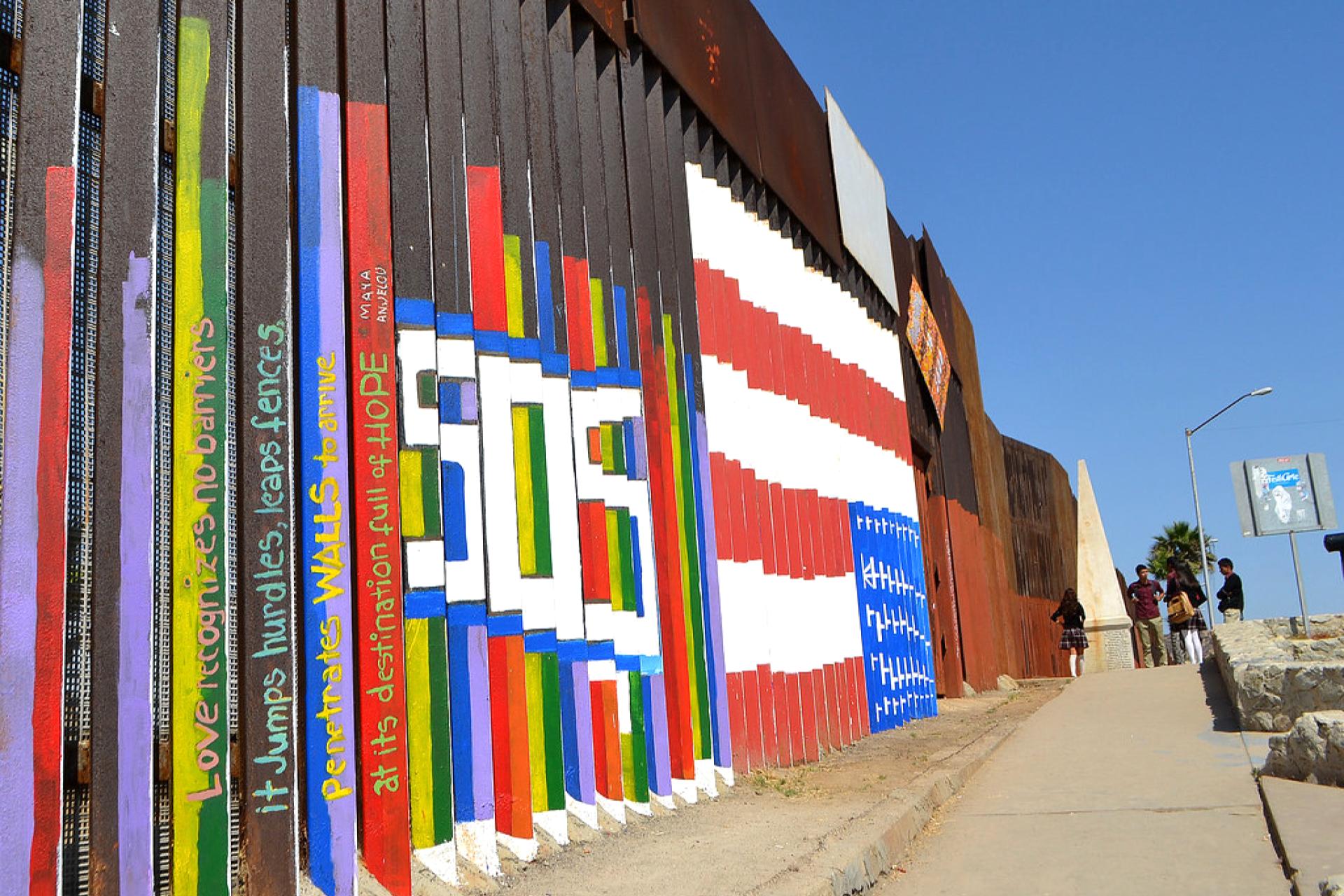With this series of weekly updates, WOLA seeks to cover the most important developments at the U.S.-Mexico border. See past weekly updates here. Leaked data show that 2022 is already the worst year on record for deaths of migrants on the U.S. side of the U.S.-Mexico border. Mayors’ complaints indicate that Texas and Arizona governors’ steady flow of migrants bussed to Washington, D.C. has begun to strain local services.
A new report shows how a rapidly changing smuggling business is using social media to sell its services, often with highly misleading claims, to an increasingly online migrant population.
MIGRANT DEATHS: 2022 IS THE WORST YEAR ON RECORD
2022 is already the worst year on record for deaths of migrants on the U.S. side of the U.S.-Mexico border, according to internal data from U.S. Customs and Border Protection (CBP). Anna Giaritelli of the Washington Examiner obtained and confirmed data showing that, since the U.S. government’s 2022 fiscal year started in October, CBP has found 605 remains of migrants. That already exceeds the fiscal 2021 full-year total of 566, which itself was a record. It is roughly double the number of deaths CBP recorded each year from 2014 to 2020.
Most migrants die painful deaths. Dehydration, heat exhaustion, or exposure at night in deserts and dry brushland appear to be the most common causes. An increasing number are drowning in the Rio Grande, irrigation canals, and other bodies of water. An increasing number are killed or badly injured trying to climb segments of the 30-foot-high border wall installed during the Trump administration. This year’s 609 deaths include the 53 migrants who perished in a hot, airless cargo trailer between Laredo and San Antonio, Texas, on June 27.
In a June 28 analysis, WOLA noted that “migrants continue to die at the U.S.-Mexico border, usually of drowning, dehydration, exposure, or falls from the border wall, with a frequency that seems unprecedented.” The new data confirms that the frequency is without precedent.
The Examiner and Reuters—which published an in-depth examination of border migrant deaths this week—both reported that CBP recorded 151 “CBP-related” deaths during the 2021 fiscal year. The term refers to deaths in CBP custody, at a port of entry or checkpoint, or while trying to elude CBP personnel.
The International Organization for Migration (IOM) maintains a separate count of migrant deaths along the U.S.-Mexico border (as well as other migrant routes). The UN-affiliated agency counts 357 dead so far during the 2022 calendar year, on pace to match or exceed the 728 it counted in 2021.
“In addition to these deaths—the worst of all outcomes—there are countless other grave injuries sustained by people migrating as a result of the dangerous routes they are forced to undertake,” recalls a July 23 statement from Annunciation House, an El Paso respite center that attends to thousands of migrants released from CBP custody each month. “Many of our guests at Annunciation House are recovering from broken bones, amputations, or other injuries that were sustained because of the border wall and draconian immigration policies. In many cases, these injuries will permanently affect their mobility, well-being, and ability to earn a living.”
As WOLA’s July 28 analysis noted, border deaths increase as enforcement policies harden in an effort to deter migrants. (Today’s record levels of migration show that decades of deterrence policies have had no effect, other than increased fatalities.) Reuters cites the “towering wall” along the border, which has channeled migrants to more dangerous desert routes, and the Title 42 pandemic expulsions policy, prolonged in May by a Louisiana federal court order, that forces many countries’ asylum seekers to avoid detection rather than turning themselves in to U.S. authorities.
“The U.S. immigration enforcement system has operated under a single premise since the creation of the Border Patrol in 1924: deterrence,” wrote Jason Buch in a July 25 essay at the Texas Observer. “It’s the idea we can somehow make coming to this country more miserable than the natural disasters, civil wars, gang violence, and economic hardship that displace people in the first place.”
Border Patrol divides the U.S.-Mexico border into nine geographic sectors. According to the 2022 data, the sector with the most reported deaths this year is the easternmost one, south Texas’s Rio Grande Valley, with 173 remains found. Giaritelli wrote, “The Del Rio region of Texas followed with 154 bodies; 72 in Tucson, Arizona; and 64 in Laredo, Texas.”
Many of the deaths in the Rio Grande Valley region actually take place about 80 miles north of the border, in Brooks County, where Border Patrol maintains a highway checkpoint that migrants seek to evade by walking for miles through dry brushland where it is easy to get lost. “There have already been 60 migrant deaths so far this year in Brooks County,” Sandra Sanchez of Border Report told the Texas Standard this week. “Last year there were 119, and in the entire Rio Grande Valley sector, there have been 140. So you can see almost half of the deaths occur in this area, Brooks County.” (For more, see the award-winning 2021 documentary Missing in Brooks County and WOLA’s podcast interview with its creators.)
Just west of the Rio Grande Valley, in Laredo, the organization Texas Nicaraguan Community reported that the bodies of four men and one woman remain in the city morgue two months after they perished because of difficulties in repatriating them to Nicaragua. “The organization says that ‘there are many suspicions of more Nicaraguans in that morgue in unidentified condition,’” according to Nicaragua Investiga.
Further west in El Paso, Border Report noted, CBP has counted 56 migrant deaths since fiscal 2022 began. Of those, 20 were drownings in fast-flowing irrigation canals, most of them in the past two months. The El Paso Sheriff told Border Report that a 42-year-old Mexican man was recovered from an irrigation canal on July 22, while the El Paso Times reported the recovery of a boy’s body from a canal that same day.
Border Report this week also profiled work to recover and identify bodies, and to help bring closure to victims’ families, in Tucson, Arizona by the Pima County Medical Examiner and the Colibrí Center for Human Rights.
Though not at the border, U.S.-bound migrants are also dying in elevated numbers at sea this year. At least 17 Haitians, including a child, died on July 24 when their 30-foot speedboat, loaded with up to 60 people, capsized about 7 miles off the coast of the Bahamian island of New Providence. “The passengers paid $3,000 to $8,000 to travel on the boat,” according to Bahamian officials cited in the New York Times.
Border Patrol “rescues” data also highlight migrants’ plight. The agency counted 16,897 search-and-rescue efforts carried out during the first 9 months of fiscal 2022, up from 12,833 in all of 2021 and about 5,000 each in 2019 and 2020.
The Washington Examiner border-wide data are revealing because CBP has not updated its official count of migrant deaths since 2020. Section 5(a) of the Missing Persons and Unidentified Remains Act ( Public Law 116-277, passed on December 31, 2020) requires CBP to produce a public annual report on migrant deaths, including—where possible—information about the decedents’ gender, nationality, and location of death. The first report was due at the end of 2021; a WOLA inquiry to congressional oversight staff found that it is still forthcoming, but the release timetable is unclear.
WASHINGTON AND NEW YORK MAYORS APPEAL FOR HELP WITH TEXAS AND ARIZONA MIGRANT BUSES
In April, Texas Governor Greg Abbott (R), an immigration hardliner up for re-election in November, began paying to place willing asylum-seeking migrants on buses to Washington, DC, after their releases from CBP custody. Since then, Texas has bused over 5,400 migrants to Washington, Abbott’s office told DCist this week. In May, Arizona Gov. Doug Ducey (R) began a similar operation; Arizona has bused 1,151 migrants to Washington, according to Border Report.
The buses arrive in Washington at random times, six days per week, near Union Station and the Capitol. They are usually met by personnel from SAMU, a non-profit with a small grant from the Federal Emergency Management Agency (FEMA), or by volunteers from the Migrant Solidarity Mutual Aid Network, which does what it can with donations.
The mayors of Washington, D.C. and New York City have begun to complain. Muriel Bowser, Washington’s mayor, told CBS’s “Face the Nation” on July 17: “I worked with the White House to make sure that FEMA provided a grant to a local organization that is providing services to folks. But, I fear that they’re being tricked into nationwide bus trips when their final destinations are places all over the United States of America.”
Volunteers, who help with transportation and even put migrants up in their homes while they make arrangements, complain that local government has not stepped up. Mayor Bowser, meanwhile, is pushing the federal government to provide more funds so that Washington, D.C. does not have to use its municipal budget to provide for the asylum seekers. “We have to be very focused on working with DC residents who are homeless and have a right to shelter in our city, especially as we prepare for the winter months,” she told a July 18 press conference. “We know we have a federal issue that demands a federal response.”
Washington mutual aid volunteer Madhvi Bahl “likened the mayor’s comments to the conservative talking point of immigrants stealing jobs from citizens,” telling DCist, “She’s pitting people against each other.”
About 10 to 15 percent of bused migrants decide to stay in the D.C. area. An Arizona official told Border Report that “about one of every four of them named New York as their destination, about one in five said New Jersey, and many of the rest were headed to Georgia or planned on staying in Washington.”
DCist reports that some asylum seekers have had to spend time in Washington homeless shelters, which in recent days have been turning them away for capacity reasons. In New York, Mayor Eric Adams claimed that asylum seekers have begun to strain the city’s homeless shelter system, calling for federal help.
Adams at first incorrectly claimed that Texas had been busing migrants directly to New York. He had strong criticism for the Republican governors: “The mere fact that they sent people out of their states, people who were seeking refuge in our country, then sent them away—did they deny that? They ended up here because they didn’t get the support there.”
Adams claimed about 2,800 asylum seekers were straining the city’s shelters, which currently are housing about 48,600 people, up from 46,000 in May. The New York Times pointed out that the shelter population often increases after the public school year ends in June, and that many asylum seekers arrive in New York on their own, without being bused by Republican governors.
Republicans, Border Report stated, “have barely contained their glee” at signs that the buses have begun to strain social services in Washington. “Looks like Mayor Bowser is starting to feel a glimpse of what it’s like to be a border community under the #BidenBorderCrisis,” tweeted the Republican minority on the intensely partisan House Homeland Security Committee.
THE REPORT LOOKS AT HOW CHANGING SMUGGLING NETWORKS EMPLOY SOCIAL MEDIA
“Migrant smuggling on the U.S. southern border has evolved over the past 10 years from a scattered network of freelance ‘coyotes’ into a multi-billion-dollar international business controlled by organized crime, including some of Mexico’s most violent drug cartels,” reads a July 25 New York Times report on the recent evolution of illegal migrant-smuggling networks.
What were predominantly “mom and pop” coyote operations that paid a “tax” (derecho de piso) to larger organized crime groups “began to change around 2019,” an Immigration and Customs Enforcement (ICE) official said in a 2021 congressional hearing cited by the Times.
“The sheer number of people seeking to cross made migrant smuggling an irresistible moneymaker for some cartels,” and total revenues, as estimated by ICE’s Homeland Security Investigations (HSI) division, “have soared to an estimated $13 billion today from $500 million in 2018.”
A July 26 report from the Tech Transparency Project (TTP) showed how smugglers use social media, especially Meta corporation’s Facebook and WhatsApp, with numerous embedded screenshots, to sell their services. Their ads often resemble those of travel agencies, using stock photos of leisure travel, “but make references to the American dream and the amount of time that travellers will be required to walk,” the report explained.
The social media messaging includes much misinformation about immigration law, for instance, claims that immigration laws aren’t being enforced at some border crossings (like Del Rio, Texas), that “the borders were opened after COVID,” or that pregnant women are allowed to enter without documents. In general, messaging makes the journey appear far less arduous and less dangerous than it is. “The misinformation has led people in the region to think it’s a lot easier to get into the United States than it is in reality,” Katie Paul of the TTP told CNN.
The group’s researchers spoke to 200 migrants in shelters on the U.S. side of the U.S.-Mexico border and in Guatemala. Nearly all carried a smartphone or tablet and used it regularly. 146 respondents said they got their information about migration conditions via word of mouth, followed closely by Facebook (140 respondents). No other information source came close: “radio,” in third place, had 58 respondents. Forty-eight reported getting information through WhatsApp.
“Respondents told our interviewers that Facebook and WhatsApp had connected them with fraudsters who stole their money, abandoned them in unsafe conditions, or gave them bad information,” the TTP reported. Though migrants are “overwhelmingly dependent on Facebook and WhatsApp,” it continued, “the platforms’ owner, Meta, has done little to stop dangerous misinformation targeting them.”








